 I would think that most children transition into using a writing implement seamlessly. But what about those who don’t? What’s going on? I know a large percentage of those on the autism spectrum will struggle with handwriting. Boys and handwriting often don’t go together. And high energy children may struggle with handwriting. Thus, do right-brained children typically have more trouble with handwriting than left-brained children? It would seem to correlate.
I would think that most children transition into using a writing implement seamlessly. But what about those who don’t? What’s going on? I know a large percentage of those on the autism spectrum will struggle with handwriting. Boys and handwriting often don’t go together. And high energy children may struggle with handwriting. Thus, do right-brained children typically have more trouble with handwriting than left-brained children? It would seem to correlate.
First, both of the universal gifts for left-brained children, word-based thinking and sequential processes, contribute to successful handwriting. The two universal gifts for right-brained children, picture-based thinking and imagination, do not. That said, picture-based thinking can result in higher abilities with drawing. So, it doesn’t necessarily mean that creative children can’t easily develop the ability to use writing implements. Right-brained children are more interested in hands-on or visual learning in their early years; whereas, left-brained children may be drawn to paper and pencil activities in the early years.
Those on the autism spectrum are typically right-brained (though autism brings in left-brained attributes). Many on the autism spectrum struggle with handwriting. But, most right-brained children are not on the autism spectrum.
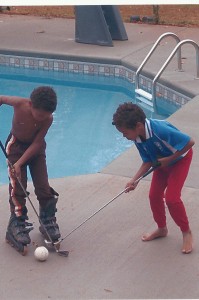 The boy gender favors the right-brained attributes. Some boys have no problem transitioning into handwriting; others do. More boys struggle with handwriting than girls, though, and the girl gender favors the left-brained attributes.
The boy gender favors the right-brained attributes. Some boys have no problem transitioning into handwriting; others do. More boys struggle with handwriting than girls, though, and the girl gender favors the left-brained attributes.
High energy children tend to develop their gross motor skills early and well. Running, jumping, kicking, climbing, sports skills, outdoor activities and work, etc. Their focus is not fine motor/sit down work in the young years. Sitting still to look at books or listen to a read aloud may be difficult enough, let alone sitting still and slowing down to write something legible. But, most right-brained children will not be high energy.
What it goes back to is embracing an individualized developmental approach taking into consideration first, the right-brained/left-brained information, and second, the individual variables, such as gender, energy levels, or things like autism. That means we have to be willing to question the typical scope and sequence for learning handwriting found in school that favors left-brained learners. My chart depicting the typical right-brained developmental learning timeframe covers all the subjects as well, just in a different order based on the natural development of a right-brained child.
The good news is that today we have more options than ever in using various technology resources that will seamlessly allow our creative, right-brained children to come to handwriting (and writing) in their own time in their own way. Currently, handwriting is introduced and expected in the 5-7 year old age range. It’s also the time when I hear the most angst coming from parents, especially of boys, who end up in struggles, crying, and refusals. It’s because we’re working against their natural development.
So what is their natural development? Looking at the learning development chart for right-brained children, they are involved in the creative outlets and story-based subjects (such as history, animals, cultures, science, and myths) in the 5-7 year timeframe. If they happen to gravitate to the art/drawing creative outlet, then you may naturally see your right-brained children drawing. If not, then you can provide resources that encourage a story without words. I saw my children enjoy such things as painting, outdoor chalk drawing, play-doh, Spirographs, stencils, LEGO, Colorforms, dry erase boards, coloring, book-making of all sorts, oral storytelling, and more. Why such things as Colorforms or storytelling? The creative expression of ideas visually or kinesthetically can often inspire our right-brained children to turn to drawing or writing something. For instance, after being introduced to Colorforms, my artist son meticulously created his own Colorforms materials by drawing a backdrop, drawing and coloring the figures, and then cutting each small piece out.
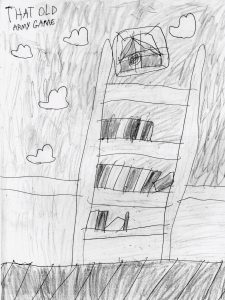
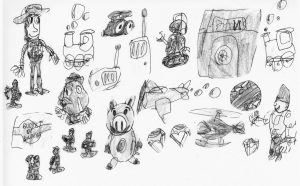
Interestingly, most of my creative boys did not choose to color. There had to be inspiration for them to do so, and even then, they may not do it. My artist son would often barter with his writer sister to color his creations for him in exchange for drawings of her choosing. I wonder if standard coloring books just didn’t ignite enough interest for my right-brained boys? Dover coloring books and the new adult coloring books may inspire more interest. My theater son became interested in developing his art skills through these types of coloring books using colored pencils starting in the 8-10 year time frame. Now, as a teen, he shades, uses different colors to mix hues, and can spend several hours dedicated to an adult coloring piece. My daughter, on the other hand, had an interest in all kinds of coloring resources. Her left-brained female gender may have impacted this area though she is a right-brained person in many aspects.
It is the 8-10 year learning stage that is best to introduce more formal handwriting introductions to right-brained children, boys in particular. This is the stage when the brain is transitioning to word-based thinking, so it supports learning more about handwriting. I remember it was at the end of this stage that my builder son requested learning cursive writing. I gave him a book that he utilized to teach himself. Interestingly, during my research, I discovered that printing stems from the left side of the brain, and cursive and calligraphy stem from the right side of the brain. The theory is that cursive and calligraphy have creative components to it, as does Japanese character writing. With this information, you may find that your right-brained child may take to cursive more quickly than print. Another interesting strategy is to ask your creative child to draw his letters versus write it. Therefore, it may take them longer to write a word, but it capitalizes on the fact that drawing stems from the right side of the brain and handwriting from the left.
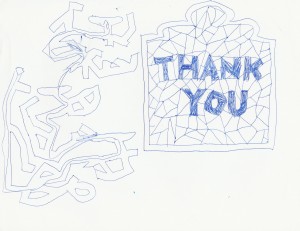 I provided space for my boys to play around with words and letters. I would often find them creating block letters, turning letters into objects, exploring mirror writing, and even taking an interest in sign language. Some people have noticed this exploration and connection to learning handwriting for right-brained children and created books as inspiration, and even learning-to-read programs that incorporate pictures into the letters or words to assist with memory. On the flip side, some experts might view mirror writing as a precursor to dyslexia. From my book, The Right Side of Normal,
I provided space for my boys to play around with words and letters. I would often find them creating block letters, turning letters into objects, exploring mirror writing, and even taking an interest in sign language. Some people have noticed this exploration and connection to learning handwriting for right-brained children and created books as inspiration, and even learning-to-read programs that incorporate pictures into the letters or words to assist with memory. On the flip side, some experts might view mirror writing as a precursor to dyslexia. From my book, The Right Side of Normal,
Letter reversal is common in right-brained learners because of their need (before age 8 to 10) and their preference (even at or after 8 to 10) to view objects three-dimensionally. So, if a child can draw a person facing to the left, or facing to the right, why can’t a “d” do the same thing? And considering a “d” and “b” simply are mirror opposites of one another, thus playing into the natural three-dimensionality of a right-brained learner, why wouldn’t the right-brained child consistently reverse them? It’s the same for “p” and “q.”
My builder son spent several months exploring his natural ability with mirror writing in this timeframe. For the most part, outside of their own natural writing pursuits, I might have them write some words each day, maybe up to ten, or a short sentence or two. No more than that.
I correlate handwriting with writing on the learning development chart, and for right-brained learners, writing begins in the 11-13 year timeframe. This is when I noticed my typical right-brained learners naturally start to write short stories, screenplays, or even novels. This is when I could start asking for longer writing samples. This is when they might develop their keyboarding skills if they haven’t already. None of these stages were a sudden explosion of handwriting, but a gradual one. Each of my typical right-brained children would initiate some project or activity that would utilize a writing implement naturally outside of what I brought to the table.
But what about those children that don’t pursue any handwriting on their own, or drawing activity, or anything close to a writing implement? Then what?
Four of my seven children fall into the category of not initiating or pursuing handwriting through their own projects or activities. First, just because they struggled with a correct grip or correct pressure or the inability to stay in a straight line or correct spacing didn’t mean I had to reject the typical timeframe for a right-brained child to come to handwriting. Everything stayed the same as the stages I shared here except that I might have to be the one initiating. That means I didn’t panic in the 5-7 year timeframe and require handwriting practice. I offered and supported their using the same materials such as stencils, play-doh, outdoor chalk, or Colorforms. I might add in some hand strengthening activities such as putting coins in a bank, pinching clothespins to an object, sewing wooden puzzles, or stringing beads. These types of activities might be on a weekly basis, not a daily one.
In the 8-10 year timeframe, I might have them handwrite five short words. I would continue to include the other creative expressions of writing implements and resources listed in the 5-7 year timeframe. This might happen a couple times a week. I might add in finding a tool to shape the hand such as a pencil grip. I might use certain occupational therapy strategies such as a broken crayon that forces a proper grip or writing on a hung chalkboard that forces the bent wrist. I might even use some gentle resources like Handwriting without Tears (remember to keep it without tears) or special paper with guidelines. But, what I’m most trying to accomplish is to maintain a positive relationship with a writing implement. If I require daily hour-long practices in various formats, what might I accomplish? A child who hates handwriting? Someone who has to struggle every day and feel they are stupid? There will not be a sudden miracle product that makes this difference vanish. But we can impact their relationship with print either positively or negatively. I choose positive. There is time enough.
And so when we reach the full integration stage of 11-13 years old, when the brain is more capable of utilizing all its resources best, I will begin a slow and steady increase in handwriting ability. At this same time, it is the stage when the brain shifts from me-centric thinking (why are you doing this to me?) to world-centric thinking (wow, I’m a little person in a big world; where do I fit?) Now they are more capable of working with someone and they are centered in their strengths as a foundation so they can more positively pursue their weak areas. I might start with writing five words daily, then move to a sentence daily, then several sentences daily. I’m looking to achieve competence which translates to quality over quantity. Again, they may never reach the ability of their peers, but they can be competent with the few items that come up in this technology-focused world. These children of mine become competent in technology at the same level as everyone else; typing when it’s relevant (most often), using voice recognition resources (like on cell phones), and choosing on-line resources (curriculum) versus hand-based ones (which can even happen at the college level). When those few things come along that require handwriting, my children have a positive relationship with their ability to do so well enough.
Here is a sample of when one of my children started off with this transition at 11 and improved by 13:
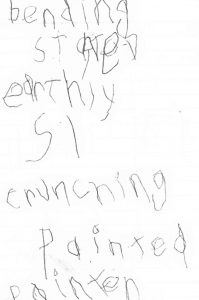
Age 11
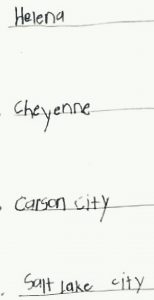
Age 13.
If we feel a need to pursue the all elusive “norm” that school purports to follow, we will set our children up for failure and find ourselves falling short. But, if we step back and actually research what is age appropriate learning, taking into consideration gender (boys have different strengths in the early years than girls) as well as other learning differences (autism, ADHD, etc.), then we will discover that the scope and sequence followed in schools miss its mark. Our right-brained children will find joy in learning. They will be honored for their particular timeframe for learning various subjects and skills. And they will shine in their strengths that will bless the world.






